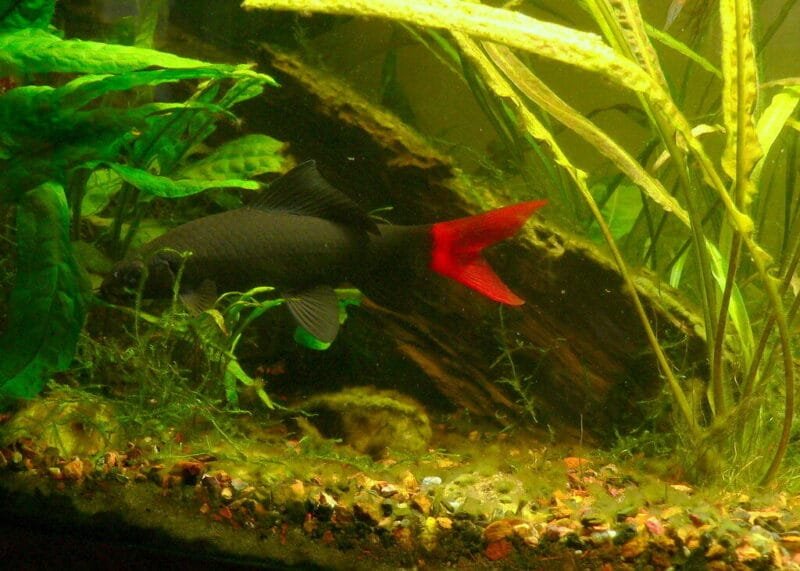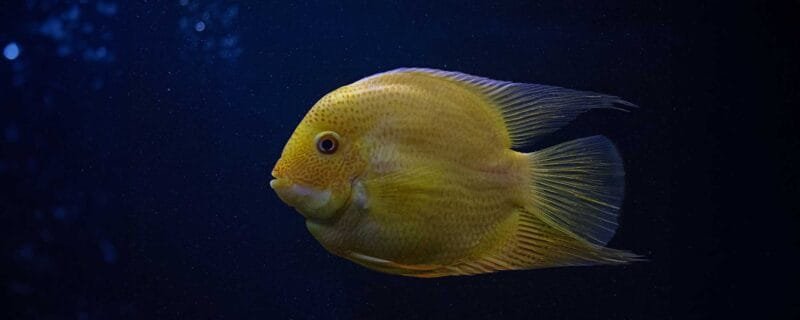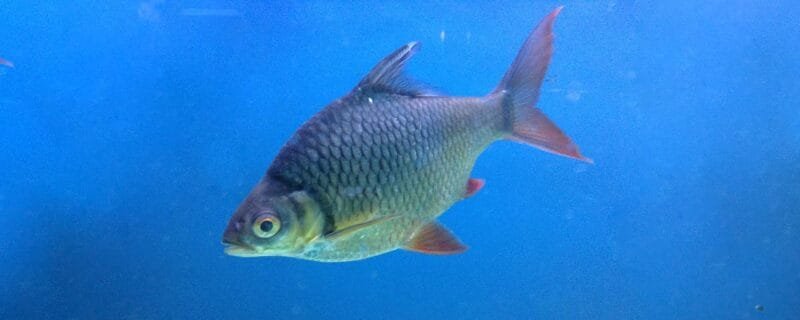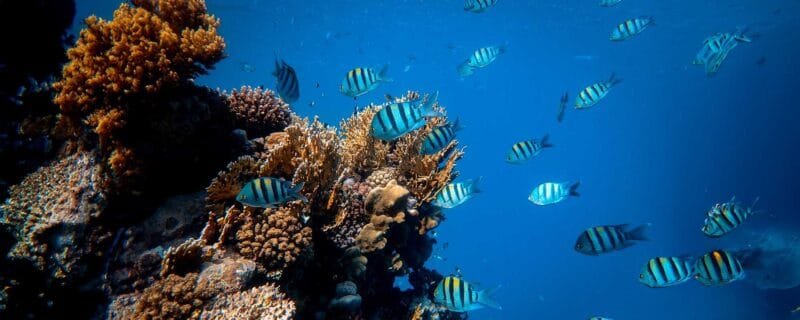The Rainbow Shark, scientifically known as Epalzeorhynchos frenatum, is a popular freshwater fish prized for its vibrant coloration and energetic behavior. Despite its name, this species is not a true shark—it simply earns that nickname from its sleek, torpedo-shaped body and pointed dorsal fin. Rainbow Sharks are a stunning addition to a tropical freshwater aquarium, but they require thoughtful tank management due to their territorial nature.
Native Habitat
Rainbow Sharks are native to the rivers and floodplains of Southeast Asia, particularly in Thailand, Laos, and Cambodia. They thrive in the Chao Phraya, Mekong, and Mae Klong river basins, where the water is warm, slightly acidic, and well-oxygenated. These fish prefer fast-moving streams with sandy or rocky substrates and dense vegetation, providing both cover and foraging opportunities. During the rainy season, they migrate into flooded forest areas rich in detritus and plant matter, which serve as breeding and feeding grounds.
Appearance and Size
Adult Rainbow Sharks typically reach lengths of 4 to 6 inches (10 to 15 cm) in captivity, though they may grow slightly larger in the wild. They have a streamlined, elongated body with a dark gray to black base color, contrasted by striking red or orange fins. This vivid fin coloration intensifies as the fish matures and remains one of its most attractive features.
An Albino variant of the Rainbow Shark is also common in the aquarium trade. Albino Rainbow Sharks have a pale white or pinkish body with the same red fins, creating a beautiful contrast. Their eyes are often pink or reddish due to the lack of pigmentation. The albino version tends to be slightly less aggressive, though this can vary by individual.
Diet and Feeding
Rainbow Sharks are omnivores with a diverse diet. In the wild, they graze on algae, plant material, small insects, crustaceans, and detritus. In an aquarium, they accept a variety of foods, including:
-
High-quality sinking pellets or wafers
-
Algae wafers for bottom-feeding nutrition
-
Blanched vegetables such as zucchini, spinach, or cucumber
-
Occasional live or frozen foods like brine shrimp, daphnia, and bloodworms
Feeding them small amounts twice daily is ideal. Overfeeding can lead to aggression and water quality issues. A balanced diet helps maintain their vivid coloration and overall health.
Sexing and Identification
Sexing Rainbow Sharks can be challenging, especially in juveniles. However, mature specimens show some subtle differences:
-
Females are usually larger with a rounder belly.
-
Males tend to have slimmer bodies and more vivid coloration, especially on the fins.
These distinctions become more apparent as the fish reach maturity, around 6 months to a year of age.
Breeding Behavior
Breeding Rainbow Sharks in captivity is extremely rare and difficult to achieve. Most specimens available in the aquarium trade are bred commercially in controlled environments using hormonal stimulation. In the wild, these fish breed during the rainy season when water levels rise and food becomes abundant.
If breeding is attempted, provide a large tank with soft, slightly acidic water (pH 6.5–7.0) and plenty of hiding spaces. Rainbow Sharks are egg scatterers, meaning they release eggs over the substrate or plants. The eggs hatch in about 3–5 days, but adults may eat the eggs, so separating them is essential. However, due to their territorial behavior, breeding pairs often become aggressive toward each other, making this process quite difficult for most home aquarists.
Tank Setup and Water Conditions
Rainbow Sharks require a minimum tank size of 55 gallons (200 liters) due to their activity level and territorial instincts. A longer tank (not a tall one) allows them to establish their territory and swim freely.
Ideal Water Parameters:
-
Temperature: 24–28°C (75–82°F)
-
pH: 6.5–7.5
-
Hardness: 5–11 dGH
Tank Setup Tips:
-
Use fine gravel or sand substrate to mimic riverbeds.
-
Add rock caves, driftwood, and dense plants to create hiding spots and visual barriers.
-
Provide strong filtration and moderate water flow to simulate natural river conditions.
-
Maintain stable water quality, as Rainbow Sharks are sensitive to fluctuations.
These fish are bottom-dwellers, so open swimming space at the top and mid-level of the tank should be maintained for other species.
Ease of Care
Rainbow Sharks are moderately easy to care for but require a bit of experience due to their territorial nature. They are hardy and adaptable if water conditions are stable, but their aggressive tendencies can cause stress to tank mates in smaller or poorly decorated tanks.
Regular maintenance—such as weekly 25–30% water changes, consistent feeding, and monitoring of ammonia/nitrite levels—helps ensure long-term health.
Temperament and Compatibility
Rainbow Sharks are territorial and semi-aggressive, especially as they mature. They tend to claim a specific area of the tank, often near the bottom, and may chase away other fish that intrude on their space.
They should not be kept with other Rainbow Sharks or similar species like the Red-tailed Black Shark (Epalzeorhynchos bicolor), as they will likely fight.
Good Tankmates Include:
-
Barbs (Tiger Barbs, Rosy Barbs)
-
Danios (Zebra Danios, Giant Danios)
-
Rainbowfish (Boesemani, Dwarf Neon)
-
Gouramis (Pearl, Three-spot, Blue)
-
Larger Tetras (Black Skirt, Congo Tetras)
Avoid housing them with slow-moving or long-finned fish such as angelfish or bettas, as they may nip at them.
Species Variations
While the most common form is the standard Rainbow Shark, there are a few notable variants:
-
Albino Rainbow Shark: White/pink body with red fins; slightly calmer temperament.
-
Black Rainbow Shark: A rarer morph with a darker body and deep red fins.
-
High-fin Variants: Selectively bred individuals with taller dorsal fins, adding to their shark-like appearance.
All variations share similar care needs and behavior patterns.
Common Health Issues
Rainbow Sharks are generally hardy but can develop problems under poor conditions. The most common issues include:
-
Ich (White Spot Disease): Caused by parasites due to stress or poor water quality.
-
Fin Rot: Often a result of bacterial infection or aggressive tankmates.
-
Fungal Infections: Appear as cotton-like patches on the body or fins.
Maintaining clean water, proper filtration, and avoiding overcrowding greatly reduce the risk of these ailments.
FAQs
1. Can I keep multiple Rainbow Sharks in one tank?
It’s not recommended. Rainbow Sharks are highly territorial and aggressive toward their own kind. Unless you have an exceptionally large tank (over 125 gallons) with ample hiding spaces, keeping more than one will likely result in fights.
2. Are Rainbow Sharks good for community tanks?
They can be kept in community tanks with fast, similarly sized fish that occupy other levels of the tank. Avoid bottom dwellers or slow swimmers to minimize conflict.
3. How long do Rainbow Sharks live?
With proper care and a well-maintained environment, Rainbow Sharks can live 6–10 years, sometimes even longer in optimal conditions.
Conclusion
The Rainbow Shark (Epalzeorhynchos frenatum) is a striking and fascinating freshwater species that adds dynamic movement and color to any aquarium. Though they can be territorial, with proper tank size, decor, and compatible tankmates, they can thrive beautifully in a community setup. Whether you choose the classic or albino variant, the Rainbow Shark’s vibrant fins and sleek form make it a standout centerpiece for experienced aquarists.





